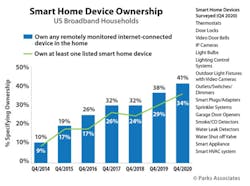The Smart Money: Smart Door Locks and Networked Cameras on the Rise
This article first appeared in the August 2021 issue of Security Business magazine. When sharing, don’t forget to mention Security Business magazine on LinkedIn and @SecBusinessMag on Twitter.
The latest consumer research from Parks Associates reveals that 34% of broadband households own a listed smart home device, up from 24% in 2018.
According to Parks Research, about 9% of U.S. broadband households report have at least one smart home lock (totaling about 9 million households) and about 10% (or 10 million households) have a networked camera. This makes smart locks and networked cameras among the most adopted smart home products following doorbells, smart light bulbs and smart thermostats.
In 2021, a large part of the growth in smart home product ownership was driven by consumers who already owned smart home products. In 2020, the average number of devices owned per household with at least one smart home device rose from 6.8 devices to 7.4 devices on average as buyers added products from new categories or bought additional units of their favorites. Continued slow and steady growth will continue in the smart home device product categories.
Residential Smart Lock Market Overview
Nearly half of smart door lock owners purchased a smart door lock as their first smart home device – a fairly sizable margin over other popular devices. Smart door lock adoption continues to be driven by strong multi-channel sales efforts and continual product innovation. Between 13 to 15 million exterior door locks are sold to U.S. broadband households each year and approximately 15% of those are smart locks. Retail constitutes the highest channel volume at 43%, with security dealers ranking second. Additionally, consumers report self-installation for nearly two-thirds of smart door locks.
The majority of residential door locks installed in the U.S. are mechanical, but an increasing number of exterior locks in single-family homes are being replaced with smart door locks. Smart door locks and associated whole building access control systems have fueled the recent acceleration in smart apartment adoption, while several major production builders now include them in standard specifications.
Feature innovations, such as biometric verification, integrated video cameras, voice control via smart speakers, and integration with home delivery services help to raise awareness and value perceptions of smart door locks. Increased awareness triggers sales in retail, security, home builder, and system integrator channels.
Smart door lock solutions have seen steady growth among a core group of enthusiasts in the past few years, but barriers impede wider and faster adoption. Although self-installation continues to grow, device setup ranks as a primary problem with almost half of new owners of smart home devices, who report difficulty in the initial setup of smart door locks. Other pain points include data security, privacy concerns, and short battery life.
Leading established players – Schlage, Kwikset and Yale – persist in dominating market share, but more recent entrants and smaller players, such as August, Latch, Lockly and Level Home, are gaining traction by improving on user experience and added benefits through partnerships, open platforms and compatibility with additional devices and providers.
One advantage of being a late entrant to the market is the ability to leverage insight from consumer response to earlier products. For example, new entrants can study today’s consumer reactions to biometric verification and setup issues. Additionally, there is anticipation for next-generation smart door locks to feature more aesthetically attuned product design, with simpler installation, longer battery life, expanded application features and fewer technical issues.
Residential Networked Camera Market Overview
Networked cameras are also a leading smart home device category, providing peace of mind and security as part of a security system or as a standalone product. After smart thermostats, networked cameras are the second leading smart home device owned by consumers. A fiercely competitive landscape provides consumers a broad mix of product and service options.
The networked camera market is fragmented, with a wide array of brands owned. ADT leads in consumer-reported brand share at 16%. With multiple brands operating in the space, and more than 7 million units sold in 2020, the networked camera market has become very competitive.
As discovered by Wyze, Arlo and others, AI enables completely new services and new service business models because of the added value it can create apart from the hardware. Offerings of video and audio analytics services, energy management services, intelligent monitoring services and cybersecurity services will help OEMs move more squarely into service business models that provide recurring revenue. AI capabilities bundled with hardware will boost the value of hardware-as-a-service offerings.
These AI capabilities are becoming increasingly important and key differentiators for networked camera manufacturers. Video and audio analytics unleash powerful features.
Furthermore, by offering high-value cameras to the market at a low price, networked camera manufacturers aim to drive-mass market adoption. AI will continue to drive business value by enabling enhanced capabilities and differentiated products and services.
Mark Vena is Senior Director of Smart Home and Strategy for Parks Associates. Tam Williams, Contributing Analyst for Parks Associates, also contributed to this article. For more information on Parks Associates research, visit www.parksassociates.com



